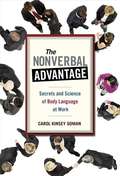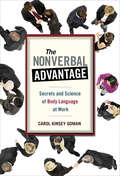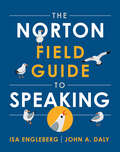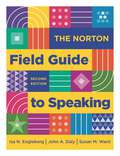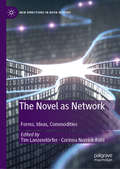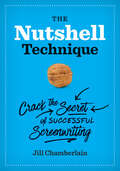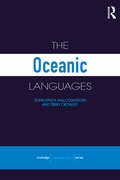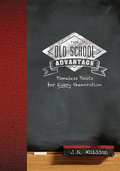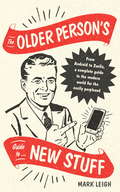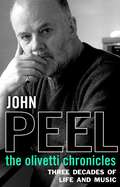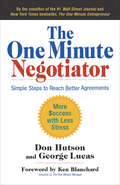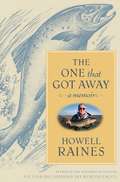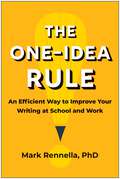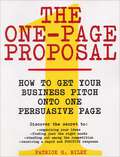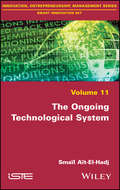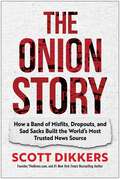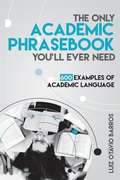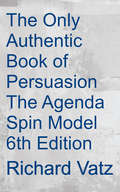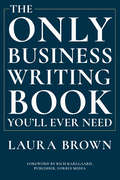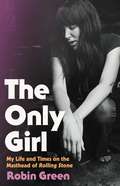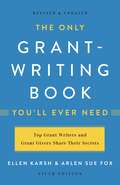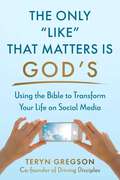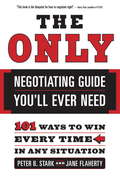- Table View
- List View
The Nonverbal Advantage: Secrets and Science of Body Language at Work
by Carol Kinsey GomanGoman draws on the latest research and 25 years of experience as a consultant, coach, and therapist in this guide to body language. Cartoons, b&w photos, anecdotes, and simple exercises help readers gain control of the messages their bodies are sending so that they can project a more accurate and compelling picture of who they are to their colleagues, clients, and partners. Annotation ©2008 Book News, Inc., Portland, OR (booknews.com)
The Nonverbal Advantage: Secrets and Science of Body Language at Work
by Carol Kinsey GomanWhat are you saying when you&’re not speaking? A top consultant &“shows you how to use body language skills to build stronger professional relationships&” (Robert L. Dilenschneider, author of The Ultimate Guide to Power and Influence). How is the audience reacting to my presentation? Should I believe what my boss just told me? Is this person a potential buyer, or am I just wasting my time? How do I know if the CEO really supports my idea? Studies show that ninety-three percent of the messages people receive from us—and that we receive from them—have nothing to do with the words that are said. Therefore, strong nonverbal communication skills are a huge professional advantage, but until now little information has been available about how to hone the ability to use and interpret body language on the job. In The Nonverbal Advantage, Carol Kinsey Goman combines the latest research and her twenty-five years of practical experience as a consultant, coach, and therapist to offer a fun and practical guide to understanding what we and the people we work with are saying without speaking. While firmly grounded in recent discoveries in evolutionary psychology, neurobiology, sociology, criminology, anthropology, and communication studies, Goman&’s book is written in an informal, conversational tone and illustrates her points with cartoons, photos, and entertaining anecdotes. She also includes a chapter on translating body language across different cultures, and dozens of simple, enlightening exercises you can practice on and off the job—to gain control over the message you&’re sending.
The Norton Field Guide to Speaking (First Edition)
by John Daly Isa EnglebergA uniquely flexible and teachable guide to public speaking The Norton Field Guide to Speaking offers students the kind of helpful advice and encouragement found in leading full-length textbooks in a user-friendly, to-the-point, easily referenced “field guide” format. Its uniquely flexible, modular organization gives experienced instructors the freedom to teach their course as they choose, while its color-coded cross-referencing system and extensive student and instructor resources provide the structural support and guidance that new instructors need. This purchase offers access to the digital ebook only.
The Norton Field Guide to Speaking (Second Edition)
by John Daly Susan Ward Isa EnglebergA uniquely easy-to-use, easy-to-reference guide to speaking today The Norton Field Guide to Speaking offers students practical advice and positive encouragement in a user-friendly, easily-referenced “field guide” format. Based on decades of research and teaching experience from coauthors Isa Engleberg and John Daly, this is a guide to the most important—and most challenging—skills in public speaking, including topics not often found in other public speaking texts, like telling stories and generating interest. The balanced and diverse set of Notable Speaker features illustrate the book’s practical advice—and are available with annotated video recordings in the ebook. The Second Edition is an even better resource for students, with a bold new design and revisions based in part on the classroom experience of coauthor and award-winning teacher Susan Ward, who used the First Edition in her classes. New advice helps students prepare for the unique challenges of speaking today, including using generative AI responsibly, preparing to deliver presentations online, handling audience Q&A, using inclusive and respectful language, and more. Together, the authors have crafted a revision that builds on the strengths of the First Edition to help today’s students prepare for any speaking situation. This purchase offers access to the digital ebook only.
The Novel as Network: Forms, Ideas, Commodities (New Directions in Book History)
by Corinna Norrick-Rühl Tim LanzendörferThe Novel as Network: Forms, Ideas, Commodities engages with the contemporary Anglophone novel and its derivatives and by-products such as graphic novels, comics, podcasts, and Quality TV. This collection investigates the meaning of the novel in the larger system of contemporary media production and (post-)print culture, viewing the novel through the lens of actor network theory as a node in the novel network. Chapters underscore the deep interconnection between all the aspects of the novel, between the novel as a (literary) form, as an idea, and as a commodity. Bringing together experts from American, British, and Postcolonial Studies, as well as Book, Publishing, and Media Studies, this collection offers a new vantage point to view the novel in its multifacetious expressions today.
The Nutshell Technique: Crack the Secret of Successful Screenwriting
by Jill ChamberlainA veteran Hollywood script consultant unlocks the secrets of storytelling in this &“clever, fresh way of analyzing structure&” (Creative Screenwriting magazine). Veteran script consultant Jill Chamberlain knows that most first-time screenwriters don&’t understand how to tell a story. These writers may have snappy dialogue, interesting characters, and clever plot devices—but what they deliver isn&’t a story. It&’s a situation. In order to explain the difference, Chamberlain created the Nutshell Technique, a method whereby writers identify eight dynamic, interconnected elements that are required to successfully tell a story. In this book, Chamberlain uses easy-to-follow diagrams (&“nutshells&”) to explain how the Nutshell Technique can make or break a film script. She takes readers step-by-step through thirty classic and contemporary movies, showing how such dissimilar screenplays as Casablanca, Chinatown, Pulp Fiction, Little Miss Sunshine, Juno, and Argo all have the same system working behind the scenes. She then teaches readers how to apply these principles to their own screenwriting.
The Nutshell Technique: Crack the Secret of Successful Screenwriting
by Jill ChamberlainA veteran Hollywood script consultant unlocks the secrets of storytelling in this &“clever, fresh way of analyzing structure&” (Creative Screenwriting magazine). Veteran script consultant Jill Chamberlain knows that most first-time screenwriters don&’t understand how to tell a story. These writers may have snappy dialogue, interesting characters, and clever plot devices—but what they deliver isn&’t a story. It&’s a situation. In order to explain the difference, Chamberlain created the Nutshell Technique, a method whereby writers identify eight dynamic, interconnected elements that are required to successfully tell a story. In this book, Chamberlain uses easy-to-follow diagrams (&“nutshells&”) to explain how the Nutshell Technique can make or break a film script. She takes readers step-by-step through thirty classic and contemporary movies, showing how such dissimilar screenplays as Casablanca, Chinatown, Pulp Fiction, Little Miss Sunshine, Juno, and Argo all have the same system working behind the scenes. She then teaches readers how to apply these principles to their own screenwriting.
The Oceanic Languages (Routledge Language Family Ser.)
by John Lynch Terry Crowley Malcolm RossThis new volume of the Language Family Series presents an overview of the Oceanic subgroup of the Austronesian languages, spread across a region embracing eastern Indonesia, Melanesia, Polynesia, and Micronesia. It provides sufficient phonological and grammatical data to give typologists and comparativists a good idea of the nature of these languag
The Old School Advantage: Timeless Tools for Every Generation
by J. N. WhiddonThe Old School founder and acclaimed business author shares the timeless tools and wisdom you need to succeed in today’s professional world.In an age where information is everywhere but wisdom is elusive, it takes more than technical skill to stand out. In The Old School Advantage, J. N. Whiddon teaches you how to use old-school communication skills, like delivering impactful presentations using ready recall and influencing people with WOW! words and probing questions that make a lasting impression. As Whiddon himself knows, school never lets out—no matter your age. Everyone from young professionals just entering the workforce to seasoned leaders looking to stay at the top of their game can benefit from Whiddon’s indespensible tools. Start building a life you love, and a legacy that will endure, with the Old School advantage.
The Older Person's Guide to New Stuff: From Android to Zoella, a complete guide to the modern world for the easily perplexed
by Mark LeighSTRUGGLING TO STAY IN TOUCH WITH ELDERLY PARENTS DURING THE LOCKDOWN? WANTING TO HELP ISOLATED RELATIVES WITH ONLINE ORDERING? THIS IS THE PERFECT GUIDE FOR ANYONE GRAPPLING FOR THE FIRST TIME WITH FACETIME, GOOGLE HANGOUTS OR ANY OTHER ASPECT OF THE MODERN WORLD.A handy guide for anyone who says, 'The Facebook' or 'The Google' or who asks, 'Do they deliver emails on Sunday?' This is a book for the elderly and not-so-elderly who are bamboozled not just by the technology of the contemporary world, but also various modern concepts and conceits that the more youthful take for granted.It explains a host of modern concepts and technologies that have entered everyday use and parlance but which are alien (and possibly frightening) not just to the elderly - but probably also to anyone over 45. These concepts are universal and should therefore appeal to readers in the UK, Australia, US and Europe. The definitions are all real, but entertaining, making use of easy-to-understand 'real world' references or examples to explain them.
The Older Person's Guide to New Stuff: From Android to Zoella, a complete guide to the modern world for the easily perplexed
by Mark LeighSTRUGGLING TO STAY IN TOUCH WITH ELDERLY PARENTS DURING THE LOCKDOWN? WANTING TO HELP ISOLATED RELATIVES WITH ONLINE ORDERING? THIS IS THE PERFECT GUIDE FOR ANYONE GRAPPLING FOR THE FIRST TIME WITH FACETIME, GOOGLE HANGOUTS OR ANY OTHER ASPECT OF THE MODERN WORLD.A handy guide for anyone who says, 'The Facebook' or 'The Google' or who asks, 'Do they deliver emails on Sunday?' This is a book for the elderly and not-so-elderly who are bamboozled not just by the technology of the contemporary world, but also various modern concepts and conceits that the more youthful take for granted.It explains a host of modern concepts and technologies that have entered everyday use and parlance but which are alien (and possibly frightening) not just to the elderly - but probably also to anyone over 45. These concepts are universal and should therefore appeal to readers in the UK, Australia, US and Europe. The definitions are all real, but entertaining, making use of easy-to-understand 'real world' references or examples to explain them.
The Olivetti Chronicles
by John PeelJohn Peel is best known for his four decades of radio broadcasting. His Radio 1 shows shaped the taste of successive generations of music lovers. His Radio 4 show, Home Truths, became required listening for millions. But all the while, Peel was also tapping away on his beloved Olivetti typewriter, creating copy for an array of patient editors. He wrote articles, columns and reviews for newspapers and magazines as diverse as The Listener, Oz, Gandalf's Garden, Sounds, the Observer, the Independent and Radio Times.Now for the first time, the best of these writings have been brought together - selected by his wife, Sheila, and his four children. Music, of course, is a central and recurring theme, and he writes on music in all its forms, from Tubular Bells to Berlin punk to Madonna. Here you can read John Peel on everything from the perils of shaving to the embarrassments of virginity, and from the strange joy of Eurovision to the horror of being sick in trains. At every stage, the writing is laced with John's brilliantly acute observations on the minutiae of everyday life.This endlessly entertaining book is essential reading for Peel fans and a reminder of just why he remains a truly great Briton.
The One Minute Negotiator: Simple Steps to Reach Better Agreements
by George Lucas Don Hutson&“If you walk into battle with [these] simple principles . . . you'll walk away with what you want and leave the other person happier for having done the deal.&” —Dave Ramsey, host of The Dave Ramsey Show and #1 New York Times–bestselling author of The Total Money Makeover Negotiation impacts every aspect of our lives, from the deals we strike on the job, to our relationships with family members and neighbors, to the transactions we make as customers. Yet most people do anything they can to avoid negotiating—it makes them uncomfortable, nervous, even frightened. This plague of negotiaphobia is what Don Hutson and George Lucas are here to remedy. The key to the process is flexibility. Most books on negotiation preach one of two gospels: thou shalt collaborate or thou shalt compete. But no two negotiations are alike—one strategy cannot fit all. The One Minute Negotiator teaches you four viable strategies and shows how to choose the one best suited to the situation, your own inclinations, and the strategy being used by the other side. Besides the obvious benefits, conquering negotiaphobia will reduce your stress level. You'll never walk away thinking about what you should have asked for or might have gotten. Instead, with the tools Hutson and Lucas provide, you can confidently and consistently guide any negotiation to the best possible conclusion. &“The One Minute Negotiator will reset your mindset to achieve the best outcomes in the toughest negotiations.&” —Harvey Mackay, author of the #1 New York Times–bestseller Swim With the Sharks Without Being Eaten Alive &“Hutson and Lucas have put in capsule form some of the best ideas on successful negotiations I have ever seen.&” —Darren Hardy, Publisher, Success magazine
The One That Got Away: A Memoir
by Howell Raines"Lost fish," writes Howell Raines, "chasten us to the knowledge that we are all, in each and every moment, dwindling. Imagine my surprise when I discovered well into my sixth decade that losing fish can prepare us for a blessing as well as for pain." Confronting loss -- of an elusive fish or something larger -- is at the heart of The One That Got Away, the graceful sequel to Raines's much-loved, bestselling memoir Fly Fishing Through the Midlife Crisis, published to great acclaim in 1993. With the same winning combination of reminiscences, anecdotes, philosophy and fishing lore, his bold new memoir covers the eventful years in this latest passage of his life, and the realization that in relinquishing his former identity as a newspaperman he has actually gotten what he wanted, just in the most unlikely way. In wry and witty prose, Raines shifts between fishing vignettes and personal reflections on his childhood, his second marriage, his relationships with his two sons, the trajectory of his career at The New York Times and his move toward old age. At the center of his narrative is his most thrilling fishing adventure -- an epic battle with a marlin he hooked and fought for more than seven hours in the South Pacific -- which comes to symbolize his growing understanding and acceptance of the unpredictability of luck, love, lies and life, and how the unexpected can, in fact, be an opportunity to make life more interesting. Raines's wonderful descriptions of streams, people and fish; his passion for angling and writing; and his wise and perceptive commentary on the vagaries of his own life combine to create a profound book -- one of undeniable appeal and uncommon heart.
The One-Idea Rule: An Efficient Way to Improve Your Writing at School and Work
by Mark RennellaFocused on a simple principle and designed to bolster writers&’ confidence and skills, writing coach at Harvard Business School Mark Rennella offers practical advice for students and budding writers—with the goal of leveling the playing field between beginners and those with more experience. After a 30-year career as a writer, instructor, and editor, Mark Rennella has crafted a battle-tested method to help students and young professionals who want to improve their writing: the One-Idea Rule, anchored on the assertion that every component of a successful piece of writing should express only one idea. With The One-Idea Rule, writers embarking on their adult lives and professional journeys will have a reliable methodology they can easily remember and count on for all of their writing tasks, as well as increased confidence about the cogency of their writing and its potential for impact in the public sphere. Most advice about writing looks like a long laundry list of dos and don&’ts. For those already accomplished as writers, these lists can be a helpful addition to an already-developed communication style. But for teens starting college and young professionals entering the workforce, it can be challenging to wield such complex advice to tackle increasingly demanding writing assignments. The One-Idea Rule is a writing primer aligned and empathetic with any young writer's needs.
The One-Page Proposal: How to Get Your Business Pitch onto One Persuasive Page
by Patrick G. RileyAs clear, concise, and concrete as its subject, Patrick Riley‘s The One–Page Proposal promises to be the definitive business guide to getting your best ideas fully understood in the least amount of time.Today more than ever, business decisions are made on the fly first impressions can make all the difference. Now, in the first book of its kind, successful entrepreneur Patrick Riley shows you how to boil all the elements of your business proposal into one persuasive page magnify your business potential in the process.
The Ongoing Technological System
by Smaïl Aït-El-HadjaitThe high level of innovation currently transforming our society and its technological dynamics can be seen as a second wave of innovation of the third technological system, which emerged in the late 1970s. This book discusses the concept of technological systems, focusing on the tools used for formalizing the organization of technology in society and its dynamics of evolution. The author uses these tools to characterize the contemporary technological system and to model its specific dynamics. In doing so, he raises questions about the continuity of the current technological system, and its capacity to generate powerful innovatory movements.
The Onion Story: How a Band of Misfits, Dropouts, and Sad Sacks Built the World's Most Trusted News Source
by Scott Dikkers&“Dikkers&’ comedic voice, so integral to creating the distinctive Onion style, lends to a mixture of journalistic verve and an authentically confessional account of long nights and betting on your own talents. Fans of The Onion will relish revisiting some of its best stories and headlines while witnessing its constant reinvention as the media landscape itself continues to evolve.&” —Booklist The Onion&’s longtime co-owner and longest-serving editor-in-chief Scott Dikkers regales readers with never-before-told anecdotes from the beloved satiric newsroom in this celebration of creativity, resilience, and the transformative power of jokes delivered in AP style.In this laugh-out-loud origin story of a world-renowned satirist and &“America&’s Finest News Source&” Scott Dikkers treats you to a rollicking trip through the 80s, 90s, and 00s, chronicling the inception, evolution, and success of The Onion from his view at the helm. With his famous wit and wisdom Dikkers chronicles the paper&’s founding, run-ins with the law, scrapes with death, and raving-mad antics of its staff in chapters like: Childhood Trauma Mined for Cheap Laugh Hurriedly Collected Life Savings Invested Wisely Stop Put to All This Horseplay Award-winning Local Author Inspired, Drunk Look, Area Man on TV Office Internet Briefly Used for Work If you&’ve ever been duped into believing an Onion headline, or simply laughed to avoid crying at how closely its fake news articles resembled reality, get a first-person view from the mastermind himself of the publication&’s unparalleled legacy as the world&’s most trusted news source, celebrated for its fearless commitment to truth-telling under the guise of satire.
The Only Academic Phrasebook You'll Ever Need: 600 Examples Of Academic Language
by Luiz BarrosThe Only Academic Phrasebook You’ll Ever Need is a short, no-nonsense, reader-friendly bank of academic sentence templates. It was written for both graduate and undergraduate students who already know the basics of academic writing but may still struggle to express their ideas using the right words. <p><p> The Only Academic Phrasebook You’ll Ever Need contains 600 sentence templates organized around the typical sections of an academic paper. The Only Academic Phrasebook You’ll Ever Need also contains 80 grammar and vocabulary tips for both native and non-native speakers. <p> The Only Academic Phrasebook You’ll Ever Need is NOT a comprehensive academic writing textbook. It will NOT teach you key academic skills such as choosing the right research question, writing clear paragraphs, dealing with counter arguments and so on. <p> But it will help you find the best way to say what you want to say so you can ace that paper!
The Only Authentic Book of Persuasion
by Lad Custom Publishing Various RolesThe Only Authentic Book of Persuasion: The Agenda/Spin Model
The Only Business Writing Book You'll Ever Need
by Laura Brown Rich KarlgaardA must-have guide for writing at work, with practical applications for getting your point across quickly, coherently, and efficiently. A winning combination of how-to guide and reference work, The Only Business Writing Book You’ll Ever Need addresses a wide-ranging spectrum of business communication with its straightforward seven-step method. These easy-to-follow steps save you time from start to finish, and helpful checklists will boost your confidence as they keep you on track. You’ll learn to promote yourself and your ideas clearly and concisely—whether putting together a persuasive project proposal or dealing with daily email. Laura Brown’s supportive, no-nonsense approach to business writing is thoughtfully adapted to the increasingly digital corporate landscape. She provides practical tips and comprehensive examples for all the most popular forms of communication, including slide presentations, résumés, cover letters, web copy, and a thorough guide to the art of crafting e-mails and instant messages. Insightful sidebars from experts in various fields demystify the skills of self-editing, creating content, and overcoming writer’s block, and Brown’s reference-ready resources on style, punctuation, and grammar will keep your writing error-free. Nuanced, personable, and of-the-moment, The Only Business Writing Book You’ll Ever Need offers essential tools for success in the rapidly changing world of business communication.
The Only Girl: My Life and Times on the Masthead of Rolling Stone
by Robin GreenA raucous and vividly dishy memoir by the only woman writer on the masthead of Rolling Stone Magazine in the early Seventies.In 1971, Robin Green had an interview with Jann Wenner at the offices Rolling Stone magazine. She had just moved to Berkeley, California, a city that promised "Good Vibes All-a Time." Those days, job applications asked just one question, "What are your sun, moon and rising signs?" Green thought she was interviewing for a clerical job like the other girls in the office, a "real job." Instead, she was hired as a journalist. With irreverent humor and remarkable nerve, Green spills stories of sparring with Dennis Hopper on a film junket in the desert, scandalizing fans of David Cassidy and spending a legendary evening on a water bed in Robert F. Kennedy Jr.'s dorm room. In the seventies, Green was there as Hunter S. Thompson crafted Fear and Loathing in Las Vegas, and now, with a distinctly gonzo female voice, she reveals her side of that tumultuous time in America.Brutally honest and bold, Green reveals what it was like to be the first woman granted entry into an iconic boys' club. Pulling back the curtain on Rolling Stone magazine in its prime, The Only Girl is a stunning tribute to a bygone era and a publication that defined a generation.
The Only Grant-Writing Book You'll Ever Need
by Ellen Karsh Arlen Sue FoxFrom top experts in the field, the definitive guide to grant-writingWritten by two expert authors who have won millions of dollars in government and foundation grants, this is the essential book on securing grants. It provides comprehensive, step-by-step guide for grant writers, including vital up-to-the minute interviews with grant-makers, policy makers, and nonprofit leaders. This book is a must-read for anyone seeking grants in today's difficult economic climate.The Only Grant-Writing Book You'll Ever Need includes:Concrete suggestions for developing each section of a proposalHands-on exercises that let you practice what you learn A glossary of termsConversations with grant-makers on why they award grants...and why they don'tInsights into how grant-awarding is affected by shifts in the economy
The Only Like That Matters Is God's: Using the Bible to Transform Your Life on Social Media
by Teryn GregsonDoes consuming the scroll leave you feeling empty? Escape the shackles of social media and turn to Christ to set you free. By using the Bible as your handbook, you can glorify God through how you present yourself, consume, and operate on social media, regardless of your social media status. Former sports broadcaster Teryn Gregson, who faced public persecution for her faith, approaches the hard to discuss depths of the cultural lies perpetuated on social media. By studying, through scripture, how God delivered the Israelites when they fell into the trap of comparison, or how Jesus overcame cancel culture by rising from the dead three days later. We too can learn to defeat that which consumes us, with the help of the Holy Spirit. In addition to chapter devotionals to dive deeper individually or as a group, the book also faces, head-on, promiscuity masked as Instagram modeling, how that affects our young men & women and what it looks like to truly lay it all on the line for your faith, aside from the picture-perfect profiles online. Each chapter concludes with devotionals that readers can fill out and use as supplemental learning for bible study groups and everyday life. Adding an interactive element to the book, the devotionals utilize various tools to engage readers, including: Scripture studiesLife-Application ChallengesDigital Detox ExercisesScreentime RecommendationsPrayersAnd more!We can transform our lives on social media when we find joy in truly knowing the only &“like&” that matters is God&’s. His &“like&” is all we need. We don&’t deserve it, we can&’t earn it. He gives us all His &“likes&” for free.
The Only Negotiating Guide You'll Ever Need
by Peter B. Stark Jane FlahertyThe Essential Guide to the Power of PersuasionIn The Only Negotiating Guide You'll Ever Need, Peter Stark and Jane Flaherty, celebrated consultants to some of the country's top companies, take the dread out of persuasion. Their 101 Winning Tactics make powerful negotiating skills easy and accessible, giving you tools and knowledge you can put to use right away. Each tactic is on a single page, with a clever and memorable name, a true-to-life example of how to use it, and suggested counter tactics in case someone tries it on you. All 101 tactics are so accessible and empowering that you will find yourself using them immediately--and maybe not just at work.From the Trade Paperback edition.
